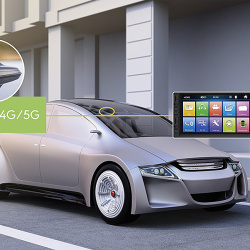Automotive Ethernet
KDPOF Introduces POF Link for Telematics Control Module
Optical Gigabit Connectivity Secures High Electromagnetic Compatibility
Madrid, Spain, April 24, 2019 – KDPOF – leading supplier for gigabit transceivers over POF (Plastic Optical Fiber) – presents an optical link concept for telematics control modules. "Several OEMs choose the IEEE Std 802.3bv™ for Gigabit Ethernet over POF (GEPOF), which is the ideal solution to connect Smart Antenna to the central communications hub while avoiding electromagnetic interference (EMI)," explained Carlos Pardo, CEO and Co-founder of KDPOF. "The optical link enhances antenna performance, whereas in conventional systems, antenna reception sensitivity is reduced by the radiated emissions coming from the electrical communications links, such as UTP (Unshielded Twisted Pair) copper cables, coax, and the shielded alternatives." KDPOF, in partnership with ALPS, has developed a concept for an LTE-A telematics control module that uses Gigabit Ethernet over POF to connect to the central communications hub such as a head unit. Since POF provides inherently high Electromagnetic Compatibility (EMC), the links do not interfere with the smart antenna receivers. With the necessary speed going beyond 100 Mbps, a 1 Gbps Ethernet link is required. Moreover, substituting the current RF link with an Ethernet data link will not only aggregate LTE-A packets but other sources such as digital radio as well.
Optical Link Concept for Smart Antenna
New plastic, composite and crystal roofs or roofs with openings do not shield the antenna from electromagnetic noise generated inside the car compartment. Instead, a significant amount of energy is radiated by the coaxial cable that is coupled back into the Integrated Smart Antenna (ISA) electronics, which severely degrades its performance. The natural EMC problem-free POF is ideally suited for an Ethernet connection, avoiding back-coupling conditions like the above mentioned one. In addition, the EMC problem-free link permits simple re-positioning of the antenna module among vehicle configurations. Another advantage is the simple integration with current ISA chipsets thanks to the Ethernet (SGMII/RGMII) host bus of the Gigabit POF transceiver. Furthermore, thanks to the Gigabit capacity of the Ethernet link over POF, the data link will aggregate various data streams such as LTE-A, Wi-Fi, V2x, RDS, DAB radio, etc.
KDPOF will present their optical link concept with Gigabit Ethernet over POF for telematics control modules at the Nikkei Tech Days on June 5 and 6, 2019 in Osaka, Japan.
About KD
Semiconductor supplier KD provides innovative high-speed optical networking solutions for harsh environments. Founded in 2010 in Madrid, Spain, KD offers its cost-effective technology as fully qualified automotive-grade ASSP, integrating electronics, photonics, and optics in a single IC. KD’s technology makes use of information theory, innovative digital adaptive algorithms, and analog mixed-signal design to maximize the receiver’s sensitivity. KD innovates in optical coupling and packaging design, which enables integration of optical communications ports in electronic control units using standard printed circuit assembly processes. Together, these offerings allow KD to support high-yield and reliable optoelectronics production in low-cost automotive-grade bulk CMOS deep submicron nodes, and to deliver products to carmakers with low risk, low cost, and short time-to-market. KD made gigabit communications for step-index plastic optical fiber (SI-POF) a reality for automotive and is now developing its multi-gigabit optimized solution for use with Glass Optical Fiber (GOF) as well.
Related News
- Battery Management System with Optical Connectivity Ready for Production
- Multi-Gigabit Communications Demand New Automotive Standard
- Optical Network Is Ready for Future Wire Harness Architectures
- Galvanic Isolation Secures New 48-volt Electrical Architectures
- KDPOF Optical Gigabit Ethernet Receives Compliance Approval from Premier Japanese Auto Industry Body
- Autonomous Driving: Optical Data Network Enhances Safety


